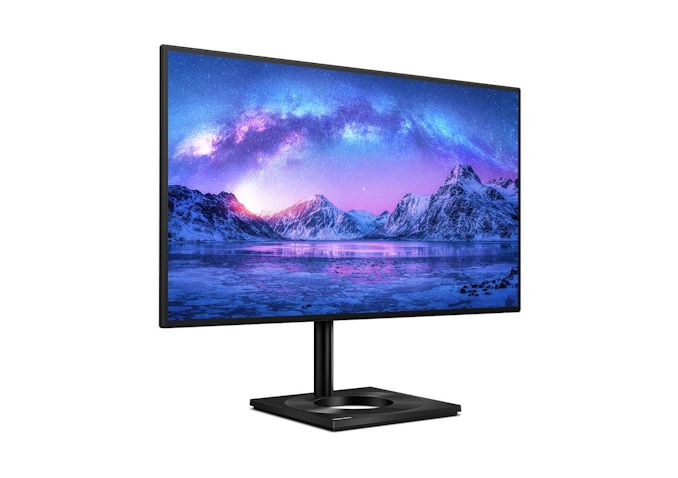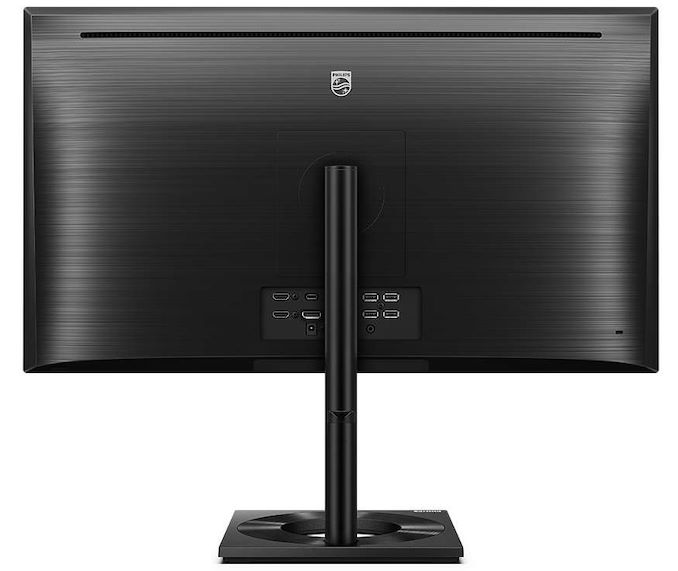MMD and Phillips Launch the 279C9 27" Montior: FreeSync 4K IPS & USB Type-C
by Gavin Bonshor on August 14, 2020 9:00 AM EST- Posted in
- Monitors
- Displays
- 4K
- Philips
- DisplayHDR
- USB Type-C
- MMD
- 279C9

This week MMD and Phillips have unveiled its latest display in their ever-growing product range, the Phillips 279C9. A 27-inch monitor aimed squarely at content creators and professionals, the 279C9 is based around a 3840 x 2160 60 Hz IPS display and includes features such as a five-port USB hub (including a USB Type-C port), as well as DisplayHDR 400 certification.
Digging into the monitor's specifications, as is typical with most content-focused monitors in this range, Phillips' 279C9 has clearly been tuned for its target market. The 3840x2160, 16:9 aspect ratio panel is a very straightforward choice, with MMD tapping an IPS panel for viewing angles and color stability. As this isn't a gaming-focused display, the monitor tops out at a 60Hz refresh rate, though there is official support for VESA Adaptive Sync to offer variable refresh support and the monitor carries AMD's FreeSync branding.
Otherwise the 279C9 has a typical static contrast ratio of 1300:1, with "Mega Infinity DCR" smart contrast technology. Meanwhile the monitor is DisplayHDR 400 certified, meaning it can offer 400 nits maximum brightness in HDR mode, and Phillips lists 400 nits as the average brightness as well. The display is framed by a fairly skinny bezel with a 596.74 x 335.66 mm (H x V) viewing area, and the screen itself is coated with an anti-glare 3H coating.
Meanwhile there is an interesting array of input and output options, including a USB Type-C input, which along with DP alt mode input allows for fast data transfer and official charging support for devices such as laptops. This is joined by dual HDMI 2.0 inputs, as well as a single DisplayPort 1.4 output. As for downstream connectivity, it also includes four USB 3.2 Type-A ports, and while Phillips doesn't distinguish between the use of USB 3.2 G2 or G1 connectivity, it is likely the latter. Two of the Type-A ports also feature USB fast charging support. Finally, the monitor includes is a pair of 2 W speakers.
| Phillips 279C9 27" Monitor Specifications | ||
| Panel | 27" IPS | |
| Native Resolution | 3840 x 2160 (16:9) | |
| Maximum Refresh Rate | 60 Hz | |
| Response Time | 5 ms (grey to grey) | |
| Contrast | 1300:1 (Mega Infinity DCR) | |
| Backlight Type | W-LED | |
| Viewing Angles | 178°/178° Horizontal/Vertical | |
| Aspect Ratio | 16:9 | |
| Color Gamut | NTSC 90.7% sRGB 109% |
|
| DisplayHDR Tier | DisplayHDR 400 | |
| Inputs | 1 x DisplayPort 1.4 2 x HDMI 2.0 1 x USB Type-C (video/data) - 65 W charging 4 x USB Type-A 1 x 3.55 mm headphone out |
|
| Audio | Dual 2 W Speakers | |
| MSRP (GBP) | £449 | |
In terms of availability, Phillips plans to launch the 27" 279C9 4K display at the end of August, with an MSRP of £449. At present, Phillips hasn't announced its US pricing or availability outside of the UK market.
Related Reading
Source: Phillips















28 Comments
View All Comments
ScarabMonkey - Friday, August 14, 2020 - link
We all love a good montior.edzieba - Friday, August 14, 2020 - link
And with Display'HDR' 400, this isn't one of them.ikjadoon - Friday, August 14, 2020 - link
Genuinely, how many people watch HDR media / movies on a desktop computer? This isn't a gaming monitor: the inclusion of type-C, the capped frame rate, the lack of red plastic, etc.Take away the specification and it's still a solid monitor for the price. The addition, or lack thereof, of HDR capabilities doesn't take away the uniqueness of this monitor.
A 4K, IPS, type-C, 100% sRGB, 400-nit, VESA-mount monitor for ~$500 (assuming conversion rates - VAT) is pretty good.
lilkwarrior - Saturday, August 15, 2020 - link
This is an asinine rebuttal. People far more prefer HDR over resolution. There's little excuse in 2020 to accept such low-end HDR on a LCD monitor.WarriorWarrior - Saturday, August 15, 2020 - link
I like your style. Just throwing out a trollish comment without citing any empirical statistic whatsoever. Nicely demonstrating yourself as that with which you assert.lilkwarrior - Sunday, August 16, 2020 - link
This is common knowledge. This is why Nvidia & many enforce HDR1000 for LCD & TrueBlack 400/500 for OLED (that LG complies with). That is why Apple even made sure for their baseline HDR monitor to have 1000nits sustained + HDR1600.namcost - Thursday, October 28, 2021 - link
WRONG.HDR1000 and HDR400/500 True Black are VESA specifications. That has NOTHING to do with Nvidia.
Nvidia USED to force 1000 peak nits in order to certify for G-Sync Ultimate, but most displays cannot get anywhere near close to 1000 peak nits so they had to scrap that idea.
https://www.tomshardware.com/news/nvidia-clears-up...
As this article mentions, Nvidia removed the 1000 nits certification for G-Sync Ultimate.
HDR1600 isn't a specification. You are making that shit. Your comment is a year old, and yet VESA HDR1400 only just became a thing this year in 2021.... your HDR1600 is a fucking joke. You are an elitist minded person with 0 knowledge and it shows.
lilkwarrior - Sunday, August 16, 2020 - link
For average joes, budget HDR has been HDR600 and HDR1000+ for creative professionals & home HDR content (1000 spec is the minimum spec required for grading of HDR video content). For those watching HDR content at home, Dolby Vision & HDR10+ also necessitate using HDR1000.OLED is an exception w/ TrueBlack HDR creteria of 400 & 500. LG, who practically supplies OLED to all the other OLED TVs & most monitors long have met this creteria.
You're grossly misinformed to state otherwise.
Spunjji - Monday, August 17, 2020 - link
Bunkum. Zero evidence exists for this assertion; in fact I'd be willing to bet 90%+ of consumers haven't even seen HDR in action. You could make an argument that it's more useful for content creators, but then if they need HDR they're going to get a proper FALD/OLED display and not screw around with a basic LCD panel.FullmetalTitan - Saturday, August 15, 2020 - link
Virtually none because this is the garbage every single company is putting into the market. I would LOVE to watch HDR movies, or play games with HDR, but I also don't want to spend $3k to be able to do so at 4k. It isn't that the monitor is bad otherwise, just that I could already buy one exactly like it for $350 2-3 years ago (which I did)